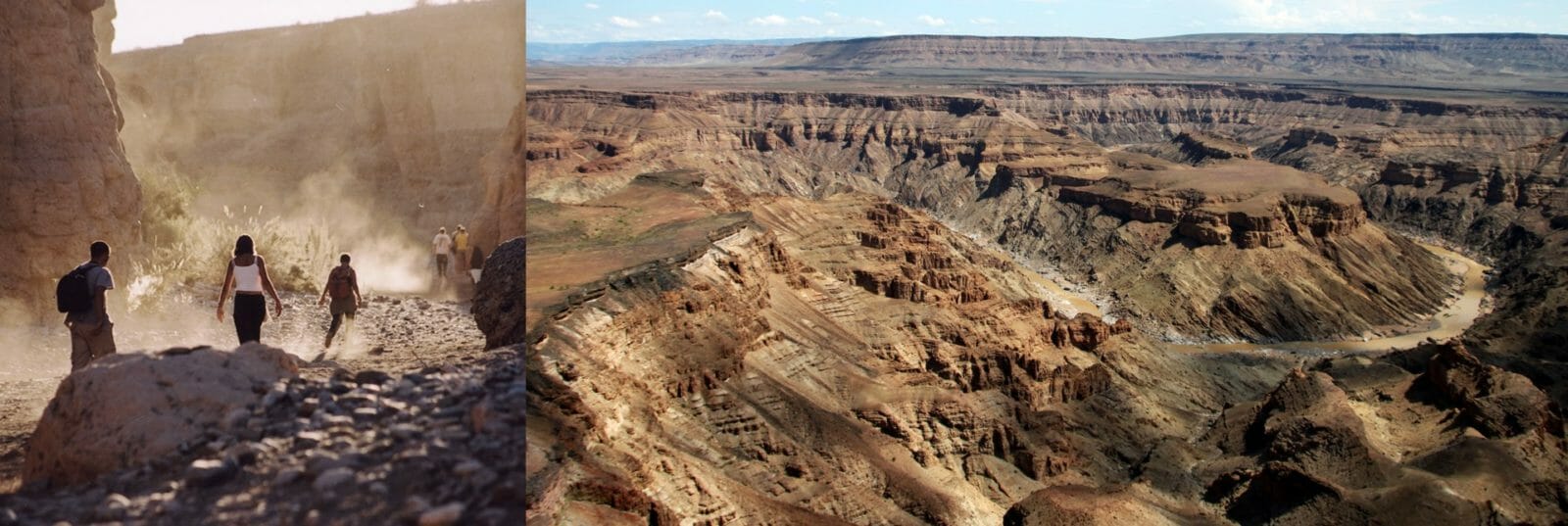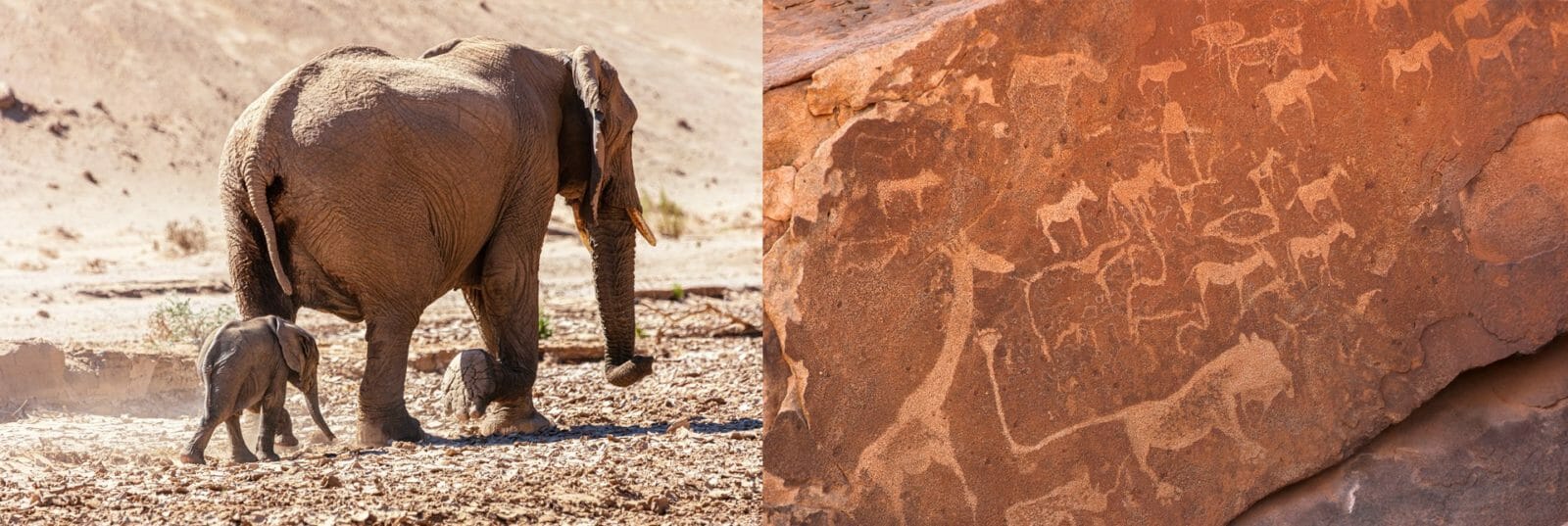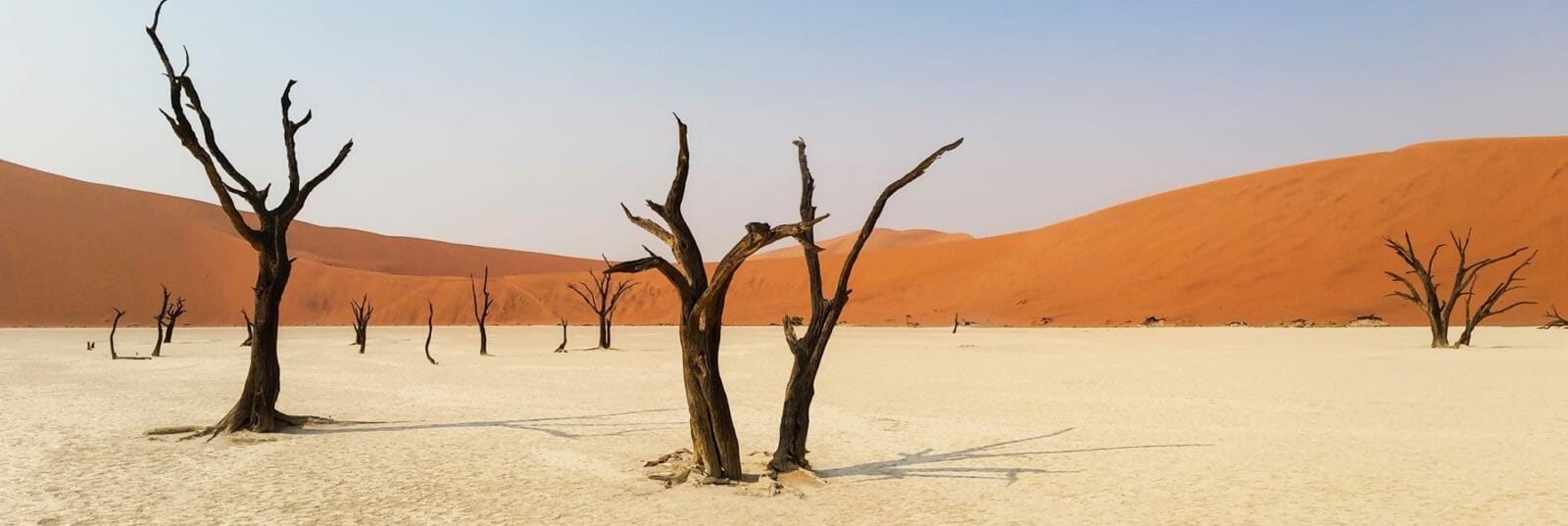
Namibia is breathtakingly beautiful, open to travel, safe, vast, affordable and almost empty of humanity. To give you an idea, it’s around double the size of California, with roughly 93% fewer people. And it’s a shining example of the best that Africa has to offer.
Famous for many things – the mountainous orange dunes of Sossusvlei, the treacherous Skeleton Coast, the far-stretching savannah and abundance of African wildlife in Etosha, the dramatic, bold granite peaks of the Spitzkoppe, the mighty Fish River Canyon, the gleaming African sunsets, the rich and ancient culture, the dark and star-studded skies. Simply put, no other country offers such visual euphoria. Namibia is unlike any other place on earth; it’s a place where you can be made to feel microscopically insignificant by the magnitude of its landscape and in complete awe of the magnificent grandeur of Mother Nature.
Here are just some of the highlights that should be included in any African safari in Namibia.

Skeleton Coast
“The Land God made in anger”, as the Skeleton Coast is called by the San people, is as far off the beaten track as it’s possible to get. Touching Angola in the north, this rough and rugged sandy coast extends for over 300 miles, ending just above the quaint Germanic town of Swakopmund.
The waters off the northern coast of Namibia are notorious for their strong currents, and where these icy waters hit the scorching desert, the land often disappears beneath the dense fog. The formidable landscape of colossal wind-sculpted dunes gives warning to newcomers with an impressive display of scattered bleached whale bones and the remains of more than a thousand rather unlucky ships.
The ultimate way to explore this untouched wilderness is by light aircraft, allowing you to see nature in her unspoiled magnificence, with the desert-adapted game, free to roam without the restrictions of fences. Namibia is conservation-focused and the wildest areas are in the northern section, and it’s kept intact by a regulation that allows only 800 visitors a year. Discover species like giraffe, black rhino, desert elephants, and even lion that are totally adapted to the arid environment, the vast colonies of Cape fur seals at Cape Cross and the enormous flamingo population near Swakopmund.
Inspired by the mysterious shipwrecks that line Namibia’s Skeleton Coast, there’s nowhere on the continent quite like Shipwreck Lodge (pictured above left). Stay in some of the most unique and dramatic accommodation on the continent Shipwreck Lodge and explore a raw, rugged, and impossibly remote slice of the African wilderness.

The Himba Tribe
Skeleton Coast offers the opportunity to visit one of the remote villages inhabited by the indigenous Himba tribe for a rare insight into their fascinating way of life. Because of their remoteness, the Himba culture has remained essentially unchanged. They are pastoralist people, depending upon their cattle, sheep, and goats for survival. This involves moving with the seasons to find grazing, and are the last semi-nomadic people in Namibia. The simple villages consist of a circle of huts built around an ancestral sacred fire. Himba women walk bare-chested and famous for covering their bodies with otjize paste, a mixture of butterfat and ochre pigment that protects their skin from the sun and gives the bodies and hair a rich reddish glow. The paste keeps them clean without the use of water and is also a good insect repellent. Ornate hairstyles and symbolic jewelry are also an essential part of their culture.
Okahirongo Elephant Lodge, is the place to stay for your Himba tribe visit. It’s also one of Namibia’s most remote destinations in Namibia, you can get there on a 2hr flight from Windhoek.
Sossusvlei
Situated within the Namib-Naukluft National Park in the southern corner of Namibia, lies the towering dunes of Sossusvlei. They say the best views come after the most challenging climb, and yes, the view from the over 300 m peak of iconic star dune Big Daddy is well-worth the arduous climb. At the base of the dunes lies the famous cracked white mud clay pan of Deadvlei, decorated with dramatic fossilized Acacia trees, leaving you with a landscape that is impossible to forget. Crossing the desert in a hot-air balloon will be an excellent lesson in scale and should be pretty high on your bucket list. If this isn’t possible, you also have the option of a quad-bike, your own feet or a sand-board.
Here in the Namid Desert you’re likely to spot the striking Gemsbok (desert oryx) with his long symmetrical horns, springboks, ostriches, jackals and hyenas.
Sossusvlei Desert Lodge is the place to stay, situated within a Private Desert Reserve, a vast 12,715 hectare (31,419 acre) expanse deep in the Namib, the world’s oldest living desert.
Set amidst an ocean of dunes, rocky outcrops and gravel plains, the utter tranquillity and extraordinary clarity of light make this area one of Africa’s most compelling landscapes. The night skies are heavenly, with the concession bordering the International Dark Sky Reserve of the NamibRand Nature Reserve. A canvas of beauty that invites reconnection with yourself and nature.
Etosha National Park
Going from deep south to high north, we fly into the Etosha game reserve, a destination with a unique identity all its own. Here is some of the finest game viewing on the blue planet. Unlike the game reserves of East Africa, Etosha is arid and dry, the animals are hardier, and the vegetation is sparse and thin. Water is scarce and a significant drawcard. Find a waterhole and sit, and you’re likely to see a grand parade of Africa’s finest game – lion, elephant, giraffe, zebra, wildebeest, to name a few. Even the rarest of the rare – the black rhino on a good day or possibly, just possibly, a leopard.
The Etosha Pan sits proudly at the center of the Etosha reserve – a completely flat, white salt pan that can be seen from outer space (if you happen to be there). It is nearly 5000 square kilometers of nothing until it rains. When filled with water, the pan attracts up to a million bright pink flamingos.
Fish River Canyon
The Fish River Canyon is the second-largest natural canyon in the world and is located in the south corner of this grand country before the eponymous river joins the mighty Orange – the border between Namibia and South Africa. It’s over 100 miles long and at certain points is over 500 meters deep. Best seen from the air, the more intrepid of adventurers can hike the canyon for as long as it takes, but only in the cooler winter months from May to September.
Damaraland
Mountainous Damaraland is a huge, untamed and rugged geographical region. It is one of the most beautiful areas in Namibia, centrally situated to the east of Skeleton Coast and southwest of Etosha.
Explore the open plains, deep gorges and impressive granite koppies (small rocky hills) in search of the indigenous wildlife that continually evolves and adapts its existence in this near-barren landscape. Residents include the mighty desert elephant, black rhino, banded zebra, and predators like the wild-maned lion, the brown hyena, and with great luck perhaps the super-swift cheetah. The sky is dotted with up to 240 avian residents including the Black-chested snake-eagle, with an impressive 6-foot wingspan.
Whilst here, be one of the privileged few to explore Namibia’s first UNESCO World Heritage Site, Twyfelfontein home to over 2500 distinctive Bushmen engravings, considered to be some of the best-preserved etchings on the African continent. These engravings and paintings on 212 slabs of rock depict the untamed wildlife and local herdsman living peacefully side by side in an old and forgotten world.
The centuries-old region was first inhabited by hunter-gatherers and later by Khoikhoi herders, both of whom used the site as a place of worship and a haven in which to conduct shamanic rituals. The area was later avoided by locals, as it was considered sacred and inhabited by the spirits of the ancestors. The best time to visit Twyfelfontein is in the late afternoons on guided walks with a highly recommended stop at the eco-friendly visitors centre, created from recycled material that’s easily dismantled and beautifully blends into the red sandstone of the environment. It illustrates displays of the native flora and fauna, as well as the rich history of the region.
If you want to do Namibia to its fullest, you would need 16 – 21 days on the ground or more.
From the desert-adapted wildlife of Etosha, to experiencing the lifestyle and rock paintings of the country’s first inhabitants, the San, the seal colony on the Cape Fria headland, to the German-influenced cuisine on offer, the wild horses of the Namib, to the mighty Big Daddy dune, to the last nomadic tribe of Namibia, the Himba and on to the center of adventure sports in Swakopmund – we could go on for hours.
Never has it been a better time to travel to experience true isolation in Namibia’s serene, stark landscapes. Namibia is doing its best to renew itself after its worst tourist year on record. Luxury lodges are dramatically cutting rates, and destinations like Sossusvlei, usually packed with travellers lining up for the best Instagram shot, are now quiet and just waiting for you to arrive.
If you’re looking for a life-changing adventure beyond the tried and tested travel routes, Namibia is the place for you.
Let Danni be your guide
“If you want to go fast, go alone. If you want to go far, go together.”












